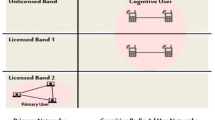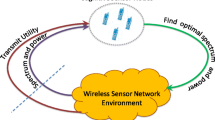Abstract
Spectrum sensing is a fundamental function in cognitive radio networks for detecting the presence of primary users in licensed bands. The detection performance may be considerably compromised due to multipath fading and shadowing. To resolve this issue, cooperative sensing is an effective approach to combat channel impairments by cooperation of secondary users. This approach, however, incurs overhead such as delay for reporting local decisions and the increase of control traffic. In this paper, a reinforcement learning-based cooperative sensing (RLCS) method is proposed to address the cooperation overhead problem and improve cooperative gain in cognitive radio ad hoc networks. The proposed algorithm is proven to converge and capable of (1) finding the optimal set of cooperating neighbors with minimum control traffic, (2) minimizings the overall cooperative sensing delay, (3) selecting independent users for cooperation under correlated shadowing, and (4) excluding unreliable users and data from cooperation. Simulation results show that the RLCS method reduces the overhead of cooperative sensing while effectively improving the detection performance to combat correlated shadowing. Moreover, it adapts to environmental change and maintains comparable performance under the impact of primary user activity, user movement, user reliability, and control channel fading.







Similar content being viewed by others
References
Lo, B. F., & Akyildiz, I. F. (2010). Reinforcement learning-based cooperative sensing in cognitive radio ad hoc networks. In Proceedings of IEEE PIMRC, pp. 2244–2249.
Akyildiz, I. F., Lee, W. Y., & Chowdhury, K. R. (2009). CRAHNs: Cognitive radio ad hoc networks. Ad Hoc Networks Journal (Elsevier), 7, 810.
Akyildiz, I. F., Lee, W. Y., Vuran, M. C., & Mohanty, S. (2006). NeXt generation/dynamic spectrum access/cognitive radio wireless networks: A survey. Computer Networks Journal (Elsevier), 50, 2127.
Akyildiz, I. F., Lo, B. F., & Balakrishnan, R. (2011). Cooperative spectrum sensing in cognitive radio networks: A survey. Physical Communication (Elseviar) Journal, 4(1), 40.
Cabric, D., Mishra, S. M., & Brodersen, R. W. (2004). Implementation issues in spectrum sensing for cognitive radios. In Proceedings of 38th Asilomar Conference on Signals, Systems, and Computers, pp. 772–776.
Ghasemi, A., & Sousa, E. S. (2005). Collaborative spectrum sensing for opportunistic access in fading environments. In Proceedings of IEEE DySPAN, pp. 131–136.
Lo, B. F., Akyildiz, I. F., & Al-Dhelaan, A. M. (2010). Efficient recovery control channel design in cognitive radio ad hoc networks. IEEE Transactions on Vehicular Technology, 59(9), 4513.
Lo, B. F. (2011). A survey on common control channel design for cognitive radio networks. Physical Communication (Elseviar) Journal, 4(1), 26.
Chen, R., Park, J. M., & Bian, K. (2008). Robust distributed spectrum sensing in cognitive radio networks. In Proceedings of IEEE INFOCOM, pp. 1876 –1884.
Varshney, P. K. (1997). Distributed detection and data fusion. New York: Springer.
Unnikrishnan, J., & Veeravalli, V. V. (2008). Cooperative sensing for primary detection in cognitive radio. IEEE Journal of Selected Topics in Signal Processing, 2(1), 18.
Selen, Y., Tullberg, H., & Kronander, J. (2008). Sensor selection for cooperative spectrum sensing. In Proceedings of IEEE DySPAN, pp. 1–11.
Visotsky, E., Kuffner, S., & Peterson, R. (2005). On collaborative detection of TV transmissions in support of dynamic spectrum sharing. In Proceedings of IEEE DySPAN, pp. 338–345.
Ma, J., Zhao, G., & Li, Y. (2008). Soft combination and detection for cooperative spectrum sensing in cognitive radio networks. IEEE Transactions on Wireless Communications, 7(11), 4502.
Visser, F. E., Janssen, G. J., & Pawelczak, P. (2008). Multinode spectrum sensing based on energy detection for dynamic spectrum access. In Proceedings of IEEE VTC-Spring 2008, pp. 1394–1398.
Zhou, X., Ma, J., Li, G., Kwon, Y., & Soong, A. (2010). Probability-based combination for cooperative spectrum sensing. IEEE Transactions on Communications, 58(2), 463.
Sun, C., Zhang, W., & Letaief, K. (2007). Cooperative spectrum sensing for cognitive radios under bandwidth constraints. In Proceedings of IEEE WCNC 2007 (pp. 1–5).
Zhang, X., Qiu, Z., & Mu, D. (2008). Asynchronous cooperative spectrum sensing in cognitive radio. In Proceedings of IEEE ICSP, pp. 2020–2023.
Song, C., & Zhang, Q. (2008). Sliding-window algorithm for asynchronous cooperative sensing in wireless cognitive networks. In Proceedings of IEEE ICC, pp. 3432–3436.
Sutton, R., & Barto, A. (1988). Reinforcement learning: An introduction. Cambridge, MA: The MIT Press.
Berthold, U., Fu, F., van der Schaar, M., & Jondral, F. K. (2008). Detection of spectral resources in cognitive radios using reinforcement learning. In Proceedings of IEEE DySPAN.
Di Felice, M., Chowdhury, K. R., Meleis, W. & Bononi, L. (2010). To sense or to transmit: A learning-based spectrum management scheme for cognitive radiomesh networks. In Proceedings of IEEE Workshop on Wireless Mesh Networks (WIMESH), pp. 1–6.
Vucevic, N., Akyildiz, I. F., & Perez-Romero, J. (2011). Dynamic cooperator selection in cognitive radio networks. Ad Hoc Networks (Elsevier) Journal (to appear).
Oksanen, J., Lundén, J., & Koivunen, V. (2010). Reinforcement learning-based multiband sensing policy for cognitive radios. In Proceedings of 2nd Int’l Workshop on Cognitive Information Processing (CIP), pp. 316–321.
Oksanen, J., Lundén, J., & Koivunen, V. (2010). Reinforcement learning method for energy efficient cooperative multiband spectrum sensing. In Proceedings of IEEE Int’l Workshop on Machine Learning for Signal Processing (MLSP), pp. 59–64.
Lee, W. Y., & Akyildiz, I. F. (2008). Optimal spectrum sensing framework for cognitive radio networks. IEEE Transactions on Wireless Communications, 7(10), 3845.
Gudmundson, M. (1991). Correlation model for shadow fading in mobile radio systems. Electronics Letters, 27(23), 2145.
Wang, H. S., & Moayeri, N. (1995). Finite-state markov channel–A useful model for radio communication channels. IEEE Transactions on Vehicular Technology, 44(1), 163.
Singh, S., Jaakkola, T., Littman, M. L., & Szepesvári, C. (2000). Convergence results for single-step on-policy reinforcement learning algorithms. Machine Learning, 38(3), 287.
Watkins, C. J. C. H. & Dayan, P. (1992). Q-learning. Machine Learning, 8, 279.
Breiman, L. (1968). Probability. Boston, MA: Addison-Wesley.
Puterman, M. L. (1994). Markov decision processes: Discrete stochastic dynamic programming. New York, NY: Wiley.
Shiryayev, A. N. (1978). Optimal stopping rules. New York, NY: Springer.
Poor, H. V., & Hadjiliadis, O. (2009). Quickest Detection. Cambridge, UK: Cambridge University Press.
Acknowledgments
This work was supported by the U.S. National Science Foundation under Award ECCS-0900930.
Author information
Authors and Affiliations
Corresponding author
Additional information
A preliminary version of this work was presented at IEEE International Symposium on Personal, Indoor and Mobile Radio Communications (PIMRC), Istanbul, Turkey, September 2010 [1].
Rights and permissions
About this article
Cite this article
Lo, B.F., Akyildiz, I.F. Reinforcement learning for cooperative sensing gain in cognitive radio ad hoc networks. Wireless Netw 19, 1237–1250 (2013). https://doi.org/10.1007/s11276-012-0530-4
Published:
Issue Date:
DOI: https://doi.org/10.1007/s11276-012-0530-4




